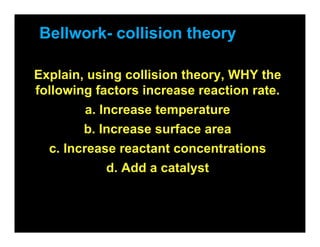Lecture 18.2a- Equilibrium
•
3 gostaram•1,120 visualizações
Section 18.2 (part A) lecture for Honors & Prep Chemistry
Denunciar
Compartilhar
Denunciar
Compartilhar
Baixar para ler offline

Recomendados
Recomendados
Mais conteúdo relacionado
Mais procurados
Mais procurados (20)
Chem 2 - Chemical Equilibrium VI: Heterogeneous Equilibria

Chem 2 - Chemical Equilibrium VI: Heterogeneous Equilibria
Chem 2 - Chemical Equilibrium X: Le Chatelier's Principle and Temperature Cha...

Chem 2 - Chemical Equilibrium X: Le Chatelier's Principle and Temperature Cha...
Destaque
Destaque (11)
Chem 2 - Chemical Kinetics VIII: The Arrhenius Equation, Activation Energy, a...

Chem 2 - Chemical Kinetics VIII: The Arrhenius Equation, Activation Energy, a...
Semelhante a Lecture 18.2a- Equilibrium
Semelhante a Lecture 18.2a- Equilibrium (20)
Core & Extension - Chemical Rxns - Reversible Rxns I.pptx

Core & Extension - Chemical Rxns - Reversible Rxns I.pptx
Chapter 6_Chemical-Equilibrium_Le Chateliers Principle-1.pdf

Chapter 6_Chemical-Equilibrium_Le Chateliers Principle-1.pdf
CBSE CLASS 10 CHEMISTRY CHAPTER 1 CHEMICAL REACTIONS AND EQUATIONS PART 1 WRI...

CBSE CLASS 10 CHEMISTRY CHAPTER 1 CHEMICAL REACTIONS AND EQUATIONS PART 1 WRI...
Mais de Mary Beth Smith
Mais de Mary Beth Smith (20)
Chapter 3 and 5 lecture- Ecology & Population Growth

Chapter 3 and 5 lecture- Ecology & Population Growth
Biotechnology Chapter Five Lecture- Proteins (part b)

Biotechnology Chapter Five Lecture- Proteins (part b)
Biotechnology Chapter Five Lecture- Proteins (part a)

Biotechnology Chapter Five Lecture- Proteins (part a)
Último
Último (20)
Unit-IV; Professional Sales Representative (PSR).pptx

Unit-IV; Professional Sales Representative (PSR).pptx
ICT role in 21st century education and it's challenges.

ICT role in 21st century education and it's challenges.
Python Notes for mca i year students osmania university.docx

Python Notes for mca i year students osmania university.docx
On National Teacher Day, meet the 2024-25 Kenan Fellows

On National Teacher Day, meet the 2024-25 Kenan Fellows
ICT Role in 21st Century Education & its Challenges.pptx

ICT Role in 21st Century Education & its Challenges.pptx
UGC NET Paper 1 Mathematical Reasoning & Aptitude.pdf

UGC NET Paper 1 Mathematical Reasoning & Aptitude.pdf
Russian Escort Service in Delhi 11k Hotel Foreigner Russian Call Girls in Delhi

Russian Escort Service in Delhi 11k Hotel Foreigner Russian Call Girls in Delhi
Lecture 18.2a- Equilibrium
- 1. Bellwork- collision theory Explain, using collision theory, WHY the following factors increase reaction rate. a. Increase temperature b. Increase surface area c. Increase reactant concentrations d. Add a catalyst
- 2. At chemical equilibrium, no change occurs in the amounts of the products and reactants. At equilibrium the system is stable H2O(s) ⇌ H2O(l) equilibrium at 0°C Means the process is at equilibrium
- 3. A reversible reaction is one in which the conversion of reactants to products and the conversion of products to reactants occur simultaneously. forward 2SO2 + O2 ⇌ 2SO3 reverse 2SO3 ⇌ 2SO2 + O2
- 4. 2SO2 + O2 ⇌ 2SO3 There are 6 mol SO2 and 3 mol O2 in a closed container As the reaction progresses, reactants form products. The forward reaction rate SLOWS as reactant concentration decreases. The reverse reaction rate INCREASES as product concentration increases.
- 5. 2SO2 + O2 ⇌ 2SO3
- 6. 2SO2 + O2 ⇌ 2SO3
- 7. When the rates of the forward and reverse reactions are equal, the reaction has reached a state of balance called chemical equilibrium.
- 8. At equilibrium the concentrations of all “species” are constant. Equilibrium position = the specific concentrations of all species at equilibrium, which can be calculated for any reaction.
- 9. SO2 and O2 SO3 react to give decomposes SO3 to SO2 and O2 At equilibrium, all three types of molecules are present.
- 10. If the rate of the shoppers going up the escalator is equal to the rate of the shoppers going down, then the number of shoppers on each floor remains constant, and there is an equilibrium.
- 11. In order to reach equilibrium you need A closed container Stable temperature Low activation energies
- 12. The equilibrium constant (Keq) is a ratio of product concentrations to reactant concentrations at equilibrium. For aA + bB cC + dD Coefficients Keq = [C]c[D]d become [A]a [B]b exponents!
- 13. A value of Keq greater than 1 means that products are favored over reactants; A value of Keq less than 1 means that reactants are favored over products. products =K reactants
- 14. 18.2 Section Quiz. 1. In a reaction at equilibrium, reactants and products a) decrease in concentration. b) form at equal rates. c) have equal concentrations. d) have stopped reacting.